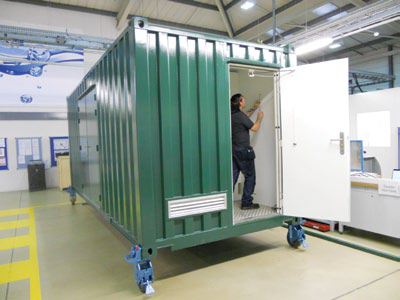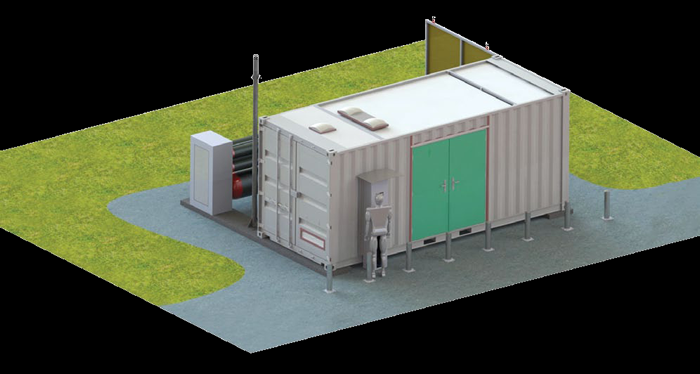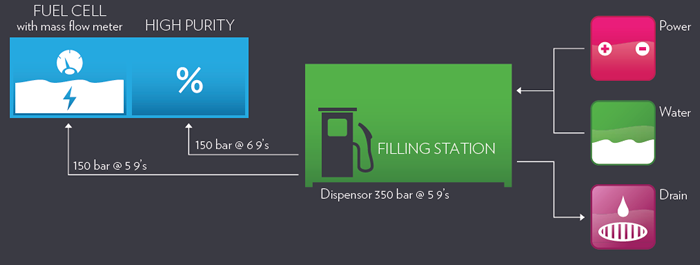This facility is based around a modular platform, which provides maximum flexibility for the customer. It contains a hydrogen production component (electrolysers) and a hydrogen storage component (compressed gas cylinders).
A Modular Hydrogen Facility at a University Campus
Contributed by | ITM Power
Background
ITM Power is a developer of hydrogen generation systems based on electrolysis. There are numerous applications for such systems in energy storage, clean fuel production and industrial supply. This case study describes a system for use by universities, the first of which is being deployed at the University of Nottingham.
The primary function of the ITM installation is to provide University of Nottingham with the capability to generate their own fuel on campus for a small fleet of fuel cell vehicles. The secondary function is the provision of a source of high purity, high pressure hydrogen for a dedicated research laboratory.
ITM managed a multi-phase process covering system specification, design, build and commissioning and now has a blueprint for a universal platform.
One of the key features of the system is the ability to increase future hydrogen generation capacity from 5kg/day to 100kg/day without significant re-engineering. It also incorporates hydrogen compression, storage and dispensing equipment appropriate for refuelling vehicles. The complete system will be CE compliant and installed on campus in Q1 2012 as a central part of the University’s New Energy Technologies Building (part funded by the European Regional development fund and the Wolfson Trust).

£9.5m Energy Technologies Building, Jubilee Campus, University of Nottingham
Product Description
The system is a containerised generation system based on ITM’s patented PEM electrolyser technology. Electrolyser capacity will be adequate to provide a minimum 5kg single charge of gas to a vehicle at 350 bar and a supply of 150 bar hydrogen to the University laboratory. Storage capacity on site will be approximately 30kg to provide a degree of flexibility to the refuelling profile.
The refueller is designed to all relevant ISO legislation (including the draft ISO 20100). The unit will be constructed and factory tested by ITM Power prior to commissioning on site. Gases from the store will feed into three processes:
- vehicle refuelling via a nozzle provided on the hydrogen filling station;
- fuel cell testing in the hydrogen laboratory;
- high purity applications (at 6 9’s purity) in the hydrogen laboratory.
Hydrogen is provided at a purity compliant with ISO 14687 (including the upcoming ISO 14687-2 standards within the gas analysis capability in the UK).

A containerised modular system

Concept view of Nottingham refuelling station
System Overview
This facility is based around a modular platform, which provides maximum flexibility for the customer. It contains a hydrogen production component (electrolysers) and a hydrogen storage component (compressed gas cylinders). As the hydrogen requirement grows, additional units containing production or storage can be deployed to suit growing end user requirements. This offering therefore enables a staged expansion of a hydrogen vehicle fleet without significant civil works.
- On site hydrogen generation by high efficiency PEM electrolyser
- Compression and storage
- 350 bar vehicle refuelling capability via WEH nozzle
- 3-5 minute refill time
- Fully automated operation
- Intrinsically safe design with technical file and safety documentation
- Tap water and 3 Phase connection are the only required services
-
Data connection and remote monitoring including: »
- Generation rates
- Amount of gas dispensed
- Compressor run time
- Stack run time
- System pressures
- Energy consumed
- Integrated thermal management
- Hydrogen leak detection
- Integrated UPS system
- Integrated purification of input H2O and output H2
- Electrically driven compressor
- Touch-screen HMI for customer recognition and fuelling operation control

System input and outputs schematic
The content & opinions in this article are the author’s and do not necessarily represent the views of AltEnergyMag
Comments (0)
This post does not have any comments. Be the first to leave a comment below.
Featured Product

